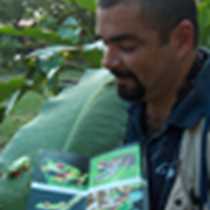Panama Canal, Buenos dias Barro Colorado Island
Today was our second day in the Panama Canal; we spent it at Buenos dias Barro Colorado Island. This research station was founded in 1923 by the Smithsonian Institution on Barro Colorado. The island is a reddish mud, clay island. This red mud is typical of rainforest soil because plants have been leaching the soil for over twelve thousand years. Plants leave behind iron and other minerals, so all you find in this tropical part of the world is reddish mud.
The research station stretches across the island and five peninsulas: Gigante, Boio, Buena vista, Frijoles and Pena Blanca.
After our wonderful breakfast we had the pleasure of listening to Antony Coates, emeritus staff of the institution, describing the wonderful habitat of rainforest ecosystems and welcoming us to the island.
We boarded Zodiacs and disembarked into Barro Colorado, and then we divided into groups and entered the wonderful ecosystem of this amazing island to hike into the forest.
We saw many palms along the trail. Some covered with tall thorns (Astrocaryum standleyanum) or thin small ones. We also saw kid brothers of the heart of palms (Bactris major) as well as thornless palms such as the royal palm (Attalea butyraceae). All of these palms produce a enormous amount of seeds that feed animals.
We saw one of the animals that interact with these palms, the agouti, (Dasyprocta punctata) a large rodent that looks like a “hamster on steroids.” These individuals are adorable creatures that store the extra nuts they can’t eat, carry them in their cheeks and hide them (like squirrels and hamsters) in a hole in the ground and mark the territory with pheromones. Agoutis don’t have the best memory in the world so they easily forget and 10-30% of these sites are discovered and eaten by Ocelots (Leopardus pardalis). Others are never found and leave a good plantation of these plants all around their territory –one would say they work for these plants.
At 2:20pm, Larry, our Expedition Leader announced over the public address system that the pilot had come on board and we would be in the Gatun Locks around 3:30. Entering the Gatun Locks (the locks towards the Caribbean) we saw a Capybara (Hydrochaedis hydrochaedis,) the largest rodent on the planet and an animal that is difficult to see. In my experience I get to see them once for every ten canal crossings. They are grass eaters and the Panama Canal’s Lake Gatun is the northern limit to this creature on the continent; it was a very exciting thing to see.
We descended a dramatic 85 feet into the Caribbean using the three sets of locks, one next to the other. Our crossing ending at about 5:20pm with beautiful light, and we ended our exceptional voyage aboard National Geographic Sea Lion.




